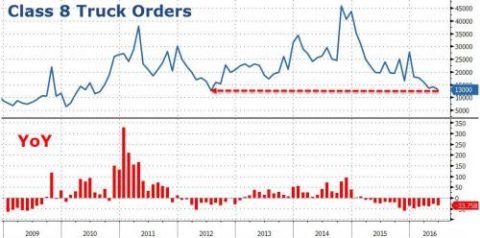By Tyler Durden
Who says you need trade and logistics to maintain the S&P within 2% of its all time high? Not the Fed, that’s who, and it’s a wonderful thing because the state of US heavy trucking – the backbone of domestic trade infrastructure and logistical supply chains – suggests the US economy is in a far more dire state than the Fed would ever admit.
According to the latest data from ACT Research released today, June orders for new heavy-duty, or Class 8, trucks plunged to just 13,100, the lowest number since 2010 according to the WSJ (and since 2012 according to Bloomberg, but no need to split hairs here) indicating that trucking companies – the forward-looking bedrock of any viable recovery along with rails – expect little relief from a weak freight market and sluggish economic growth. This month’s order activity was the lowest monthly total since July 2012 and the worst June since 2009.

As the WSJ reports, Trucking companies ordered 13,100 Class 8 trucks, which are used for long-haul routes, the fewest orders since the third quarter of 2010 and a more-than 30% drop from last year. With the manufacturing levels depressed thanks in part due to the strong dollar, and retail inventory levels high, freight volumes have not kept up with the ramp up in truck orders in recent years, leading to overcapacity, said Kenny Vieth, ACT’s president. Truck orders plummeted last fall and have held at low levels throughout 2016. “In a nutshell, Class 8 sales far outpaced freight creation through 2015 and early 2016, causing a capacity glut, which the industry is now paying for” with lower profits, Mr. Vieth said.
That is one explanation. Another is that traditional clients of the OEMs have far better visibility into the order book, and contrary to the rosy projections presented by the Institute for Supply Management, the future is dreadful enough to put all future orders on indefinite hold.
Meanwhile, trucking companies including Swift Transportation have said in recent months they are shifting some vehicles to the spot market and idling others in order to manage the tougher market.
“Fleets are cautious as freight demand has cooled off this year,” said Don Ake, vice president of commercial vehicles at FTR, another research firm which reported similar order numbers. “There are enough trucks to handle freight right now with carriers [in] a wait-and-see mode before adding trucks or replacing older units.”
Which is another way of saying nobody wants to spend on growth because it simply is not there.
Ake added that “the Class 8 market is stuck in a holding pattern, at the bottom end of this cycle. This is what the summer looks like in a market down cycle, so we can expect this level of activity for a couple more months.”
There was some optimism: “We do anticipate higher orders later this year. However, the volume of orders will be determined by the strength of the economy and freight activity at that time.”
As the WSJ adds, in another sign of a weakened freight market, the American Trucking Associations said Wednesday that driver turnover at large truckload fleets, which traditionally have trouble keeping drivers, decreased 13 percentage points in the first quarter to 89%–the lowest level since the second quarter of 2015.
“The decline in turnover is reflective of the softening in the freight economy during the first quarter,” said Bob Costello, chief economist at the ATA. And that, in turn, is reflective of the softening in the US and global economy, a softening which today appears set to push the S&P500 back over 2,100 yet again.
Source: Domestic Trade Is Disintegrating: Heavy Truck Orders Plunge To Lowest Since 2010


